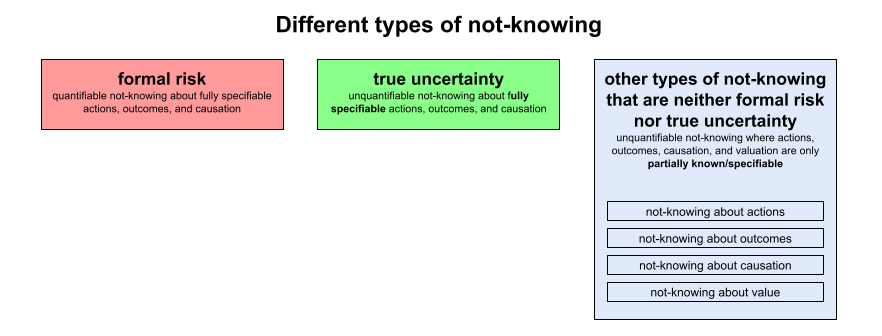The fountain
15/10/2023 ☼ not-knowing ☼ risk ☼ uncertainty ☼ strategy ☼ time
tl;dr: This is the reading for the 10th episode in my monthly discussion series on not-knowing. The four types of not-knowing — actions, outcomes, causation, and values — affect each other over time. So any reasoned approach to not-knowing must accommodate how a change in one of the four affects the others. Compared to the narrow risk-management approach, this broadened understanding of not-knowing opens up a fundamentally different way of thinking about the world and how to take action in it. The tools for relating to not-knowing naturally also look different from risk-management tools.
Not-knowing is a new way I’ve developed to analyse situations where we only have partial knowledge. I think it’s a more useful framing of partial knowledge than the currently pretty confused terminology around “risk” and “uncertainty.” (If you’re new to this framing, here is an introduction to not-knowing.)
In addition to risk, we routinely confront not-knowing about possible actions and outcomes, not-knowing about causation, and not-knowing about relative value — and time and futurity (things that might happen in the future) condition not-knowing. These four types of not-knowing trigger each other unpredictably causing not-knowing to proliferate over time, analogous to a fountain that keeps running once its pump has been primed.
 Risk, true (Knightian) uncertainty, and other types of not-knowing.
Risk, true (Knightian) uncertainty, and other types of not-knowing.
There are two sides to not-knowing’s odd, unpredictably loopy form of self-generativity. On the one hand, continually multiplying not-knowing can be terrifying or at least uncomfortable. On the other hand, not-knowing can become a source of strategic advantage for organisations that are prepared for it.
An example: A pharmaceuticals startup observes that its large incumbent competitors are heavily invested in conventional drug development approaches. It decides to strategically create not-knowing about possible actions by investing in R&D to come up with a new and much faster drug development approach. This potentially creates not-knowing about possible outcomes (by making new drug targets addressable) and not-knowing about causation (by changing the reliability with which drugs can be developed). The new drug development approach might also create not-knowing about relative value (by making new framings of drugs possible, e.g., individually tailored therapeutics).
(This, loosely speaking, is the Moderna story of focusing on developing RNA therapeutics at a time when the vast majority of drugs were small molecules or proteins.)
A strategy of not-knowing
As the pharmaceutical example suggests, intentionally creating not-knowing is the underlying story of what we call strategically disruptive innovation. Using not-knowing as a strategic tool requires being more comfortable with not-knowing than your competitors, and intentionally creating not-knowing in ways that work for you, that you’re ready to take advantage of. This requires being equipped with a mindset, approaches, and tools suitable for not-knowing.
A mindset suitable for not-knowing
All mindsets are clusters of beliefs. These beliefs determine what people and organisations perceive, how they interpret what they perceive, and how they act based on their interpretations.
In The Uncertainty Mindset, I described the uncertainty mindset as a cluster of beliefs that openly admits that uncertainty exists and explicitly distinguishes it from risk. This is why people and teams with this uncertainty mindset don’t assume that the unknown future can be quantified and optimised (as the risk mindset tends to do. The uncertainty mindset leads them to design different organisation processes for hiring, goal-setting, and motivation, which in turn lead to more adaptable and innovative organisations. At root, the uncertainty mindset is simply “a mindset that acknowledges and embraces uncertainty.”
Not-knowing is a broadened conceptualisation of partial knowledge — it encompasses Knightian uncertainty and risk so it can relate them to each other and to other kinds of partial knowledge.
Building on the insight of the simple foundation of the uncertainty mindset, the most important components of a mindset for not-knowing are the willingness to explicitly acknowledge the presence of not-knowing, and the clarity to distinguish between its different forms.
Action approaches suited to not-knowing
Because of futurity affects not-knowing, the action approaches suited to not-knowing will be those which are built around explicit expectations of incomplete knowledge, learning, ongoing change, and evolution. This means expecting to build and rebuild teams as projects evolve toward completion, not starting by assembling permanently ideal teams. It also means discussing and negotiating organisation values in terms of tradeoffs repeatedly, instead of assuming that values are well-understood and unchanging. Expecting change and evolution means approaches that are inherently provisional.
Tools for non-risk not-knowing
We have robust tools for risk-management built over decades of research and theorising — these almost all rely on action approaches that assume knowability and optimisability. The action approaches for not-knowing outlined above suggest that tools for non-risk not-knowing must look different from risk-management tools. Some of these tools already exist and are in use, but not yet understood to be tools appropriate for dealing with non-risk not-knowing. Building an appropriate toolkit will require finding these existing tools and figuring out how to use them, like physicians discovering off-label uses for drugs already in the market. And surely other tools will have to be dreamed up before we learn how to use them.
We’ll discuss mindset in ep. 11, broad approaches in ep. 12, and tools in ep. 13.